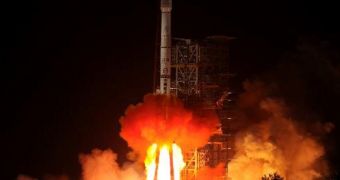A large Chang Zheng (Long March) 3B Y-23 rocket that took off from China on Sunday, December 1, carried the Asian nation's first-ever lunar lander into Earth's orbit. The Chang'e-3 mission consists of a lander and a six-wheeled robotic rover, which are scheduled to land on the Moon on December 16.
The spacecraft were manufactured by the Shanghai Aerospace System Engineering Institute for the Chinese National Space Administration (CNSA), and launched from the modern Xichang Satellite Launch Center (XSLC), in Sichuan Province, at 17:30 UTC.
Chang'e-3 is scheduled to achieve orbital insertion around the Moon on December 6, at around 2:30 UTC. Its arrival will be observed and confirmed by the NASA Lunar Atmosphere and Dust Environment Explorer (LADEE) spacecraft, which has been analyzing the Moon since October 6.
After spending roughly ten days in lunar orbit, the new Chinese mission will attempt to land in a crater called Sinus Iridum on December 16. The spacecraft is named after the goddess of the moon in Chinese mythology. The small rover is called Yutu, which means Jade Rabbit, Chang'e's pet.
If CNSA manages to land Chang'e-3 successfully on the surface of the Moon, then China will become only the third country in history to put a lander on Earth's natural satellite, following the Soviet Union and the United States.
This spacecraft is the third in a series of vehicles meant to boost CNSA's prestige and space exploration capabilities. Two other vehicles went to the Moon in 2007 and 2010, but both were orbiters and made no attempt to land, PhysOrg reports.
Chang'e-3 will have a landing mass of around 1,200 kilograms (2,600 pounds), including the rover, which will weigh 120 kilograms (260 pounds). The small robot is just 1.5 meters (4.9 feet) tall. Since the Moon has only been studied in passing, the explorer is likely to make some new scientific discoveries on its own.
With this new mission, CNSA again reaffirms its position as a strong contender in the international space community. China and India are currently on the verge of starting a new space race, this time among themselves. They both have vast wealth at their disposal, and a drive to conduct space exploration that Russia and the United States appear to have lost over the years.

 14 DAY TRIAL //
14 DAY TRIAL //